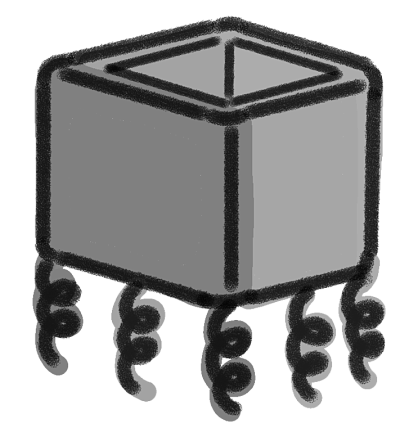 We designed a DNA Origami structure with CaDNAno .json file, and we proved the stability of the design with CanDo in order to find the most stable model.
We designed a DNA Origami structure with CaDNAno .json file, and we proved the stability of the design with CanDo in order to find the most stable model. We were able to construct experimentally the DNA box by following different strategies. Once found the reproducible conditions for the folding reaction, we tested the theoretical optimal temperature and two more temperatures.
We were able to construct experimentally the DNA box by following different strategies. Once found the reproducible conditions for the folding reaction, we tested the theoretical optimal temperature and two more temperatures.  We could characterize our device with AFM.
We could characterize our device with AFM.  We obtained Iron Oxide NanoParticles (IONPs) functionalized with the alkoxysilane APTES and we characterized the functionalization with 3 different methods: TEM, FTIR and Zeta Potencial.
We obtained Iron Oxide NanoParticles (IONPs) functionalized with the alkoxysilane APTES and we characterized the functionalization with 3 different methods: TEM, FTIR and Zeta Potencial.  We conclude that the best of the three estrategies for constructing the device was using the Option 2, which consists of a folding reaction with the 4 double-stranded scaffolds and the 33 staples all together. Also we found that the optimal experimental temperature was, at least in our experiments, 68°C.
We conclude that the best of the three estrategies for constructing the device was using the Option 2, which consists of a folding reaction with the 4 double-stranded scaffolds and the 33 staples all together. Also we found that the optimal experimental temperature was, at least in our experiments, 68°C.After constructing "La Caja" we think this project can be extended in several aspects.
 First of all, the assemble of the device by joining the IONP with the DNA box must be characterized. The characterization can be by Zeta Potencial and Cryo-TEM.
First of all, the assemble of the device by joining the IONP with the DNA box must be characterized. The characterization can be by Zeta Potencial and Cryo-TEM. To make a math model about the different temperatures and MgCl2 concentrations.
To make a math model about the different temperatures and MgCl2 concentrations. To prove experimentally that the device can actually isolate biomolecules.
To prove experimentally that the device can actually isolate biomolecules.  To make a molecular model in order to predict how the device will bind to aptamers.
To make a molecular model in order to predict how the device will bind to aptamers. As the highest proved temperature was the one that showed more cubes constructed, we plan to test the folding reaction with 3 more temperatures.
As the highest proved temperature was the one that showed more cubes constructed, we plan to test the folding reaction with 3 more temperatures.